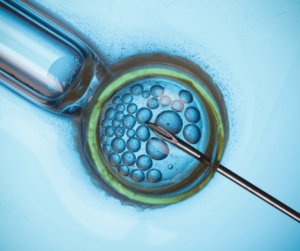How is the process of intracytoplasmic sperm injection (ICSI) performed?
The process of intracytoplasmic sperm injection, or in vitro fertilization (IVF), is one of the most well-known and effective assisted reproductive technologies for treating infertility issues. The principle of this technique is based on fertilizing the wife’s eggs outside the womb with the husband’s sperm, and after the embryo forms, it is implanted inside the mother’s uterus, which increases the joy of achieving pregnancy and childbirth. In this article, we will explain how the process is carried out in detail.
First, what is intracytoplasmic sperm injection?
Intracytoplasmic sperm injection, abbreviated as (ICSI), is one of the techniques of in vitro fertilization (IVF), where a single sperm is injected directly into the egg to achieve fertilization outside the womb, followed by the implantation of the embryos into the uterus.
What are the cases in which intracytoplasmic sperm injection is resorted to?
There are many cases in which intracytoplasmic sperm injection is resorted to, and these cases include:
- Weak motility or abnormal morphology of sperm.
- Low sperm count.
- Blockage in the reproductive ducts of the husband preventing sperm from reaching the egg.
- The presence of antibodies attacking the sperm.
- Failure of previous artificial insemination attempts.
- Inability of sperm to penetrate the egg’s outer layer.
- Issues with erection or ejaculation in the husband.
- Blockage of the fallopian tubes through which the eggs pass to the uterus for fertilization.
- Endometriosis outside the uterine cavity.
- Severe pelvic adhesions.
- The desire to fertilize frozen eggs.
How the microinjection process works in detail:
After completing the doctor’s evaluations and conducting the necessary tests and examinations, the microinjection process begins, which consists of the following stages:
The first stage starts with ovarian stimulation:
The main objective is to obtain the largest possible number of high-quality eggs, which is achieved through hormonal medications. Afterwards, the doctor monitors the growth of the eggs using ultrasound and blood tests to ensure the eggs are mature.

The second stage is egg retrieval:
The egg retrieval process is performed through a simple procedure using a thin needle from the vagina to the ovary to extract the eggs, under local anesthesia.
The third stage is preparing the sperm:
On the same day as the egg retrieval, a sample of the husband’s semen is collected naturally. If there is an issue with sperm production in the husband, the doctor can take the sample directly from the testicle through a simple medical procedure. After that, this sample is processed in the laboratory to separate healthy and strong sperm from weak sperm.
The fourth stage is fertilization (injecting a sperm into the egg):
In this stage, a healthy sperm is selected and injected directly into the egg using a very fine needle. This process ensures fertilization even in cases of weak sperm and is the essence of the microinjection process, requiring high skill from the doctor to ensure the egg is not damaged.

The fifth stage is monitoring fertilization and embryo development:
After injecting the egg with the sperm, the fertilized eggs are placed in special incubators to monitor fertilization. The eggs are then examined after 18-24 hours to confirm that fertilization has occurred and that cell division is taking place.

Stage Six Embryo Transfer to the Uterus
After two to five days from fertilization, the best embryos are selected for transfer to the mother’s uterus using a fine catheter. This stage is performed without anesthesia as it is relatively painless.
After the embryo transfer, the wife takes a rest for several hours, thus completing all stages of in vitro fertilization (IVF). A pregnancy test is conducted two weeks after the transfer to confirm the success of the pregnancy.
Tips to Ensure the Success of IVF:
- Follow a healthy diet rich in vitamins, minerals, and Omega-3 to improve egg quality.
- Avoid smoking and alcohol consumption as they affect the quality of sperm and eggs.
- Maintain an ideal weight to improve chances of conception.
- Ensure mental and physical relaxation and reduce stress.
Post-IVF Procedure Tips:
There are several tips to follow after the IVF procedure to ensure the success of the procedure:
- After embryo transfer, the wife should take adequate rest and avoid any physical exertion.
- Follow a healthy diet rich in vitamins and minerals.
- Regular follow-up with a gynecologist to monitor the pregnancy.

What are the Success Rates of IVF?
The success rate of IVF varies based on several factors such as the woman’s age, the cause of infertility, and the quality of sperm. Generally, it is divided into two rates:
- 44% for women aged between 18 and 35.
- Less than 30% for women over 35 years old.
What are the potential risks and complications?
The intracytoplasmic sperm injection (ICSI) procedure is largely safe, but there are some potential complications, which include:
- Ovarian hyperstimulation syndrome due to ovarian stimulation, leading to fluid accumulation in the abdomen.
- Failure of the egg to grow and develop into an embryo after being injected with sperm, resulting in fertilization failure.
- Incomplete development of the embryo.
- Occurrence of multiple pregnancy syndrome, depending on the number of embryos transferred, thus increasing the risk of premature births.
- Increased risk of giving birth to children with congenital defects.
ICSI is a complex medical procedure that requires highly skilled medical staff and fertility centers with significant experience. As mentioned, there are risks and potential complications, but it remains a good option for couples unable to conceive due to its high success rate.
This content has been approved by doctors at Zein Clinic.
To contact a doctor and receive a free consultation, click here:
Did you like our topic? You can share it with your friends now!
Sources:
Read more:
The conditions and standards for conducting IVF
The difference between IVF and artificial insemination
artificial insemination success factors


 واتساب
واتساب